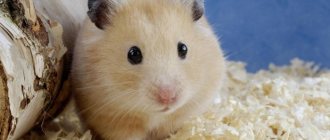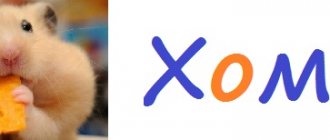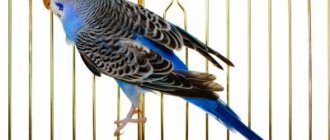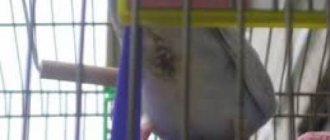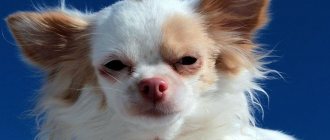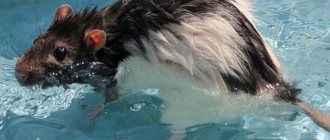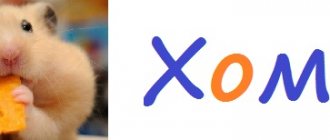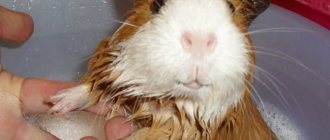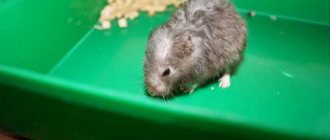Wavys are cute domestic birds that need constant care from the owner. The health, mood and life expectancy of the pet depend on the correctness of this process.
Therefore, sometimes you even have to trim the bird’s beak. It is important to understand the nuances of how to trim a budgie’s beak correctly and not harm your pet. Additionally, it is necessary to use certain preventive measures aimed at preventing the growth of the stratum corneum.
Is it necessary to trim the horny part?
The bird's beak consists of several parts, which include:
beak;- mandible;
- tendon ligament;
- the cere on which the nostrils are located.
The beak is not fused with the skull, which ensures its mobility. The bone is covered on top with a special horny layer, which grows throughout the bird’s life.
Wavys constantly use their beak, which leads to abrasion on the sides. The abraded stratum corneum constantly grows, so under normal conditions it is completely replaced within 6 months.
In any case, the owner needs to monitor the condition of the beak . If necessary, the excess horny part is cut off.
The beak is a significant organ for a parrot, since with its help the bird cleans feathers, grabs food and other objects, builds a nest, feeds chicks, protects itself from other birds and gets rid of pests.
If the bird was unable to grind off the horny part on its own, then it begins to have difficulty performing normal actions. Difficulties may arise even with independent feeding.
This leads to decreased activity and deterioration of plumage. If the bird cannot eat at all, it will get sick and die from exhaustion. Sometimes wavy birds actually injure themselves while cleaning their feathers.
It’s also useful to read: Why does a parrot’s beak peel off?
The role of the beak for a parrot
The beak only in appearance seems hard, stone, lifeless. This is a sensitive organ of touch; it helps the bird to sense heat and cold, touch, and the shape of objects. Also, with the help of its beak, the budgie performs the necessary actions:
- crushes and grabs food;
- cracks nut shells;
- cleans and smoothes feathers;
- combs out parasites;
- builds a nest (loop);
- carries objects;
- climbs trees or cage bars;
- turns eggs;
- feeds the chicks.
The beak is needed not only to ensure the life of the parrot. It has another important purpose: this attribute of appearance serves to intimidate opponents. Defending territory, the bird screams furiously, bites and plucks feathers from its opponent.
Reasons for the growth
If the owner of a wavy bird notices that even with regular trimming, the beak is growing too quickly, then the cause of the problem must be determined.
This is usually due to the following reasons:
- Poor nutrition . In addition to standard grain mixtures and soft fruits, the bird's diet includes solid foods such as nuts or cereals. Among fruits, preference is given to firm apples and pears.
- Hormonal imbalances . They occur during frequent egg laying or stressful situations. Therefore, it is necessary to provide a calm and quiet environment for the bird.
- Liver problems . They can only be identified during an examination by a veterinarian, who can take tests and identify diseases.
- Frequent trimming. Some owners get too carried away, so they start trimming the beak literally every other day. This leads to rapid growth of the stratum corneum.
- Lack of means for grinding. Sometimes a parrot simply does not have the ability to sharpen its beak on its own. Therefore, the owner must ensure that the cage contains twigs or tree bark. You can buy special chalk or other ready-made poultry products.
- Lack of vitamins or minerals . To eliminate the problem, you can buy special vitamin supplements to restore elements.
If you identify the cause of beak enlargement, you can quickly correct the problem and improve your pet’s condition.
It’s also useful to read: Growth on a parrot’s beak
Accelerated growth
When getting a pet, owners do not always know about the rules for keeping it. That's why they make some mistakes. Rapid enlargement of the nose in a domestic parrot often occurs due to overfeeding with minerals and from:
- There is no special stone, so there is no possibility to grind off the excess.
- Lack of hard food.
In order not to encounter the problem of accelerated beak growth, the budgerigar and other breeds are provided with conditions that are close to natural.
One of the reasons for the rapid growth of the beak
How to properly trim the horny part at home
The procedure is carried out carefully, since if done incorrectly, irreparable harm can be caused to the wavy. It is advisable to involve a second person in the process, since one will hold the bird, and the second will perform the necessary manipulations to trim off the excess part of the beak.
If the owner has experience, he can do the pruning himself.
Required Tools
To trim the horny part of the beak, the following equipment is prepared:
- a special tool that is sold in pet stores, and in appearance it looks like nail scissors;
- a small piece of cotton wool;
- alcohol or other antiseptic;
- hydrogen peroxide, which is useful if the integrity of the blood vessel is compromised.
The beak contains blood vessels, so it is important to trim in such a way as not to damage them. But the bird may jerk at the wrong moment, causing damage to living tissue. This causes bleeding, which can be stopped with peroxide. To avoid damaging the vessel, it is recommended to illuminate the beak with a flashlight before creating a cut.
Has your parrot been sick?
Not really
The process of cutting off excess parts
To cut off the tip of the beak, the following steps are performed:
- instruments are treated with alcohol or other disinfectant;
- work is performed in good lighting;
- the bird is fixed in the hand, for which the wings are pressed against the body, but you cannot press too hard;
- the beak is illuminated with a flashlight to determine where the blood vessels end;
- You can mark it with a pencil so you know where to make the cut;
- it is impossible to cut off the stratum corneum in one movement, so it is advisable to make small sections;
- the procedure is carried out until the beak takes on a suitable shape;
- at the end of the process, treatment is carried out with a weak solution of potassium permanganate or hydrogen peroxide.
After the procedure, the bird is transplanted into a cage, and the wavy birds often experience stress, so they need to be left alone for a while . It is important to give your pet clean water, but remove the food for about 4 hours. This is necessary so that germs and contaminants do not get into the small cracks and frames that form during trimming of the stratum corneum.
It is recommended to treat tools used during the process with alcohol.
Eating disorders
Minerals and vitamins must be present in the bird’s diet. Their lack disrupts the entire body from the desired rhythm. This causes the nose and claws to grow quickly. Fatty foods affect not only their length. The liver and metabolic processes suffer.
In order not to encounter this problem, it is necessary to balance the parrot’s diet and create the necessary living conditions.
The growth of the beak is also affected by injuries, as a result of which the pet develops an incorrect bite.
Malnutrition as a consequence leads to accelerated beak growth
In adults, due to hormonal imbalance, rapid growth of the nose is also observed.
Possible problems
Difficulties may arise when cutting off excess parts:
- you cannot cut off too much of a part, as this can lead to the appearance of significant cracks, and the beak may burst, so harmful bacteria can easily penetrate into the crack;
- if you use rough instruments, such as nippers or forceps, as this often leads to excessive cutting of the stratum corneum, so the bird will bleed;
- if living tissue is touched and blood appears, then it is necessary to pour hydrogen peroxide onto a cotton swab, which is then applied to the wound.
If the procedure is performed by a beginner, then it is advisable to cut off the beak in small parts. Although the process takes a lot of time, it helps to obtain the desired result.
Parasites
There are cases when growths appear on the beak due to the presence of parasites on the bird. If observed:
- nose enlargement;
- growths similar to papillomas around the eyes, on the wax, paws,
then these are symptoms that parasitic microorganisms have settled on the pet. To get rid of them, you need to treat areas with growths with aversectin or novertin ointments.
Prevention of overgrowth
To prevent excessive growth of the horny part, it is recommended to use certain preventive measures.
These include:
- toys and objects are placed in the cage, with the help of which the wavy can easily grind off the excess parts on the beak, for which only wooden elements are selected;
- it is important to regularly buy your pet a mineral stone, which not only acts as a source of microelements, but also allows the bird to sharpen its beak;
- The diet includes solid foods such as grains and seeds.
Vitamins are useful products for any bird, but there is no need to overdo it with them, so the dosages indicated on the package are taken into account.
Why trim a parrot's beak?
As the parrot grows, so does its beak. It is very important that this organ is in a healthy condition. If a budgerigar has grown a long beak, this interferes with its full life, so the owner needs to trim it from time to time.
An overgrown stratum corneum interferes with the normal consumption of food, hygiene procedures, communication with you and the pet’s comfortable existence.
Budgerigars need their beak not only for eating food, they use it as a “hand” or a third “leg”: when they climb the bars of a cage or on a play stand, take objects, move them from place to place, and play with toys. In addition, with the help of this “hand” birds explore the world, touch and perceive heat and cold.
In the wild, the beak is also a weapon with which birds defend themselves from enemies, making frightening clicks, plucking and biting. It also helps build nests for future offspring.
That is why it is so important that the budgie’s stratum corneum is in a healthy state.
Is nail trimming painful for parrots?
It does not harm the bird if you pinch your nails. This can be compared to cutting human hair or cutting nails. But please note: this does not harm the bird as long as you hold the bird correctly. Don't squeeze her or her paws. If you cannot do this, contact your veterinarian and ask for help. Or let your avian veterinarian show you how to trim your budgie's nails yourself.
Mites on a parrot's beak
Budgerigars whose beaks are infested with mites often suffer from severe beak malformations. Sometimes it grows too long and in some cases the wrong shape. You may want to help, but it is very dangerous to trim a beak that has structural damage caused by mites.
Structure of the nails of a budgerigar
Bird nails are comparable in some respects to human nails. There are "dead" parts, but in the inner part of the wavy nail there is a blood vessel that supplies the growing part of the nail with nutrients. In general, this blood vessel is easy to see—as long as the bird doesn't have dark nails. If you want to know more about the position of the blood vessel, you just need to look through your nails held in front of a bright light.
Most wavy birds, as well as some other small birds, have clear nails and light will shine through them and you will see the blood vessel as a dark area.
You should avoid touching this part of your bird's nail when trimming it.
What you need
To properly trim a parrot's beak, you will need several things:
- special veterinary instrument or sharpened nail scissors or clippers;
- nailfile;
- needle file;
- cotton swabs;
- medical alcohol;
- hydrogen peroxide or hemostatic powder for animals;
- soft cloth or towel.
How to trim
The entire process requires great care and caution.
- Wrap the bird in fabric so that the head remains outside. An assistant should hold the bird and fix the head with his hand.
- Treat instruments with medical alcohol.
- You can trim a budgie's beak with regular nail scissors; for larger breeds you will need pliers that provide strong pressure. Make sure that the scissors do not touch the bird's eyes and tongue.
- Horny tissue can be cut off where it does not exfoliate or crumble. The peeling parts are cut off.
- Mark the location of the cut: cut a small piece at a time from the side, at an angle to the middle, to get a natural shape.
- Wait until the bird freezes so as not to injure it, and then make a quick movement.
- Try not to touch blood vessels. In parrots with a dark beak they are completely invisible, so you need to be even more careful.
- If the vessel is damaged, press a cotton swab with hydrogen peroxide onto the wound or sprinkle it with anti-bleeding powder. Instead of peroxide, you can moisten cotton wool with a solution of Dicynon.
- After cutting, file down the sharp edges. You can sharpen the beak of a lovebird and other small birds with a manicure file, but for large pets you will have to use a needle file. Watch your movements so as not to injure the bird.
- Immediately after the procedure, put the parrot in a cage, give it its favorite treat and do not disturb it for the next 24 hours.

